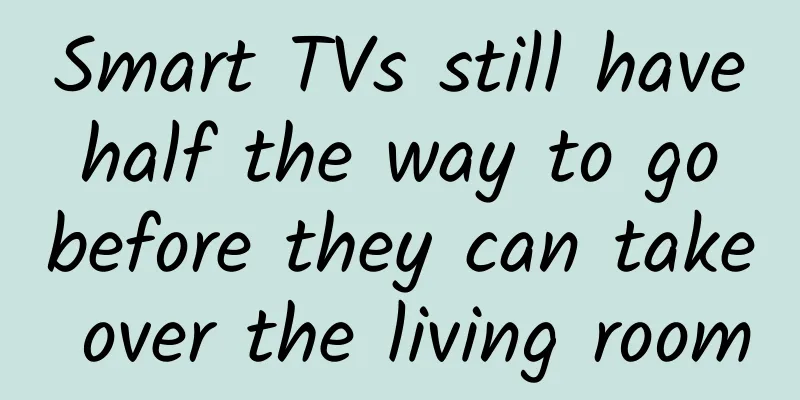Smart TVs still have half the way to go before they can take over the living room

|
Since the concept of smart TV came into being, the topic of occupying the living room has never stopped. Even almost all TV manufacturers hope to use their smart TVs and smart systems as a starting point to bundle users through software, services, etc. to achieve a goal similar to a complete ecosystem. However, despite the efforts of all manufacturers, "occupying the living room" is still just a slogan to this day. Therefore, in my opinion, the reason why the current smart TV market is still divided and there is no monopoly is not that consumers have nothing to buy, but that there is not much to watch and nothing to play. Smart TVs to be launched in 2015 According to previous data from Aowei, the retail volume of the color TV market reached 22.11 million units in the first half of 2015, a year-on-year increase of 5.6%; the retail sales reached 74.4 billion yuan, a year-on-year increase of 6.9%. It is also predicted that the scale of color TVs will exceed 45 million units in 2016, and will maintain a steady low-speed growth in the next two years. Indeed, since the explosion of smart TVs in the past two years, both traditional home appliance manufacturers and emerging Internet companies have continuously launched new products of various models. According to our rough statistics, in the first half of this year alone, many international and domestic TV manufacturers, including Skyworth, Hisense, LeTV, Lenovo, Samsung, LG, Sony, etc., have launched new products. In addition, the smart TV market, which continues to heat up, is gradually moving towards high-end, intelligent, and large-screen products, in addition to the continuous launch of new products from various brands. Moreover, due to the continuous upgrading of new product technologies, new products such as curved, ultra-thin, and quantum dot have entered the market in batches, which constantly stimulates the attention of consumers. Taking high-end models as an example, Sony announced the launch of the previously highly anticipated 4.9mm ultra-thin TV Sony X9000C series, with a starting price of 19,999 yuan; Sharp's 8K TV was also officially released in China; after announcing the mass production of 4K OLED, Skyworth officially launched a full range of OLED TVs, with the flagship model starting at 39,999 yuan, etc. It can be seen that the smart TV market is still hot this year, with high-end, mid-range and low-end products available, which can almost meet any needs of consumers. Video and game applications are the mainstay of living room entertainment at this stage According to AVC forecast data, the value of the living room economy will reach 230 billion yuan in 2015, and it is expected to exceed one trillion yuan in 2020. Obviously, the living room is destined to become the focus of competition among TV manufacturers. In fact, although the scope of living room entertainment is not limited to TV, TV still shoulders an important mission in the living room entertainment of consumers. From the perspective of consumer usage habits, Aowei's previous data shows that among the smart TV functions that consumers value, video on demand accounts for 85%, followed by game applications. Therefore, major smart TV manufacturers will naturally do their best in these two aspects. In terms of video, despite the restrictions of radio and television policies, major manufacturers will still find their own corresponding ways to highlight their own advantages in video. In particular, some new Internet TVs use various exclusive video resources to attract consumers' attention. For example, LeTV previously announced that the 3D movie "Nine-story Demon Tower" adapted from the novel "Ghost Blowing Light: The Ancient City of Jingjue" will be exclusively broadcast on LeTV Super TV; in terms of content, the newcomer Weijing TV, in addition to having good voices, NBA, and Hollywood blockbusters, also emphasizes family entertainment functions. It has cooperated with many international entertainment companies such as DreamWorks and Lego, claiming to provide the best family entertainment content for Chinese families; PPTV's new products also claim to have 24-hour non-stop video content, and feature live video programs of the No. 1 sports exciting events including CBA, AFC Champions League, Chinese Super League, Premier League, etc. As for games, according to previous forecasts by market research company Newzoo, from 2012 to 2016, the size of the TV game market will be US$24.3 billion, US$25.4 billion, US$26.2 billion, US$27 billion and US$27.9 billion respectively, showing a steady growth year by year. In addition, the domestic game console market after the ban did not seem to bring much surprise to players, which left a lot of room for game applications in smart TVs. Although real game console players are not rare to those Android games on smart TVs, there is no doubt that in the living room game environment with large-screen TVs as the carrier, it is indeed very tempting for mass players. In a survey on game TVs conducted by Tencent Home Appliances last year, 18% of netizens said that they often use TVs to play games, which ranks second in demand for TVs, second only to the demand for watching videos. To this end, in addition to the "cloud game" platform previously released by Alibaba and Baidu's TV game platform, Konka jointly launched the T60 with Tencent Games in March this year, which can play games with QQ voice; Hisense has started to build the Juhao Game Platform, which is also based on Tencent games, and connects to a large number of third-party games developed according to the standards of this platform. Popular mobile games such as "Everyday Wind Journey", "Everyday Cool Run", "Everyday Speed Car", "QQ Landlord", "Brave Adventure" and so on can all be experienced on the TV; in order to enable its smart TVs to have more gaming experiences, the giant Sony has also fully equipped its new products this year with the Android system, making up for the previous shortcomings in entertainment. The hardware is sufficient but the content is the key However, with the smart TV market booming with new hardware products and manufacturers bombarding video and game applications, smart TVs still seem to be a little short of taking on the banner of living room entertainment - I believe there are still many friends who would rather sit on the sofa in the living room and watch videos or play games on their phones than turn on the TV. First of all, although major smart TV manufacturers are intentionally or unintentionally skirting the rules in terms of video on demand, the content will inevitably be restricted until the pressure from policies is completely eliminated. In fact, the strong suppression of Internet video boxes by the radio and television last year also affected the smart TV field to some extent. The most memorable thing is that Hisense aggregated the content of 11 video websites. Under the strong pressure of the radio and television, the video on demand applications of TV boxes and smart TVs did stop for a while. During that time, when launching new products, everyone honestly emphasized that they had cooperated with the seven licensees and emphasized the legitimacy of their video content. It can be said that no one dared to act rashly. Of course, after the limelight passed, some "active" companies began to make small moves secretly. Various situations similar to the previous Hisense aggregation video website began to appear. I even heard that a certain video website has planned to launch its own brand of smart TVs. In addition, through various channels, video aggregation applications are installed on smart TVs, and mobile phone videos are projected onto the TV screen for playback. Application scenarios such as these have also begun to be hinted to consumers in the promotion of new products of various companies. Regarding the above questions, I once asked the relevant person in charge of a TV company, and the answer I got was simple: no one cares now. But the truth is obviously not that simple. Even if it is really the case that "no one cares now", TV companies are still wary of this "secret" approach. This can be proven by the previous incident between LeTV and Xiaomi, as well as the attitudes of all parties in the "false" rumors that the radio and television will issue four more strict regulations. In the absence of a grasp of the strength of radio and television policies, all actions taken by TV companies in terms of video content are risky. Therefore, under such a background, the homogeneity of smart TV video on-demand content will definitely continue to exist. Secondly, due to the fact that most of the current smart TVs and TV boxes are based on the Android system, both in terms of hardware structure and software development, they are mainly based on casual games. The few big titles can hardly whet the appetite of real game players, let alone attract traditional game console players, which is simply a fantasy. In Tencent Home Appliances' previous reviews of smart TVs and TV boxes, we can see that there are basically two ways to download games to smart TVs. One is to download them in the TV's own application market, and the other is to download them on game aggregation platforms such as the AIWI somatosensory game platform, Dongyou game platform, ATET game platform, Xiaocong game platform, etc. But no matter which download method is used, the game content is mostly educational, chess, and somatosensory. Although a previous survey by Aowei also showed that consumers' interest in somatosensory games reached 53%, second only to online video on demand and multi-screen interaction. But I don't think it's because the experience of the game is so attractive in terms of gameplay, but it's a helpless choice for players under the poor and scarce operation methods of smart TV games. Of course, a large part of the reason is that players want to try out the somatosensory operation method. Perhaps various cloud gaming platforms may become the main carriers of smart TV game masterpieces in the future, but for now, several major obstacles such as fees, small number of games, and high network environment requirements have really kept living room players out. An industry expert once said that the TV game industry is currently quite hot, but consumers are not so enthusiastic about it. Smart TV games are currently in the content production and cultivation stage. The payment method, experience and design of TV games need to be closer to large-screen terminals such as TVs to truly attract consumers to play on TV. Summary: You are still halfway to occupying the living room It is not a fantasy that smart TVs will take over the living room. It is also a very obvious trend, both in terms of the development of the entire industry and the attention paid by various TV companies. However, we have to admit that due to the current shortcomings in related software and operation methods, smart TVs can only be placed in the living room. If they want to truly "occupy" the living room, there is still a long way to go. As a winner of Toutiao's Qingyun Plan and Baijiahao's Bai+ Plan, the 2019 Baidu Digital Author of the Year, the Baijiahao's Most Popular Author in the Technology Field, the 2019 Sogou Technology and Culture Author, and the 2021 Baijiahao Quarterly Influential Creator, he has won many awards, including the 2013 Sohu Best Industry Media Person, the 2015 China New Media Entrepreneurship Competition Beijing Third Place, the 2015 Guangmang Experience Award, the 2015 China New Media Entrepreneurship Competition Finals Third Place, and the 2018 Baidu Dynamic Annual Powerful Celebrity. |
Recommend
Will taking a nap make you stupid?
Source: A Brief History This article has been aut...
Self-media communication made "The Monkey King: Hero is Back" a box office miracle
When Lost in Thailand suddenly became popular for...
China Space Day丨The stars and the sea, never stop!
April 24 The 7th China Space Day Turn back the clo...
10 PPT slides and 5 steps to teach you how to write first-class copy!
How to write first-class copy ? This has always b...
2021 Team Value Investment Director Wu Muyang and Wu Muyang's Circle (Medium and Long-term Bands)
2021 Team Value Investment Director Wu Muyang and...
The life-and-death feud between Steve Jobs and these six people
A new biography of Steve Jobs, released Tuesday, ...
What does the bank do when you withdraw money from an ATM?
If you take an ICBC card to a CCB ATM and withdraw...
How a weather warning is generated: A look at the entire warning process from the landing of Typhoon Siam
In recent days, under the influence of Typhoon Si...
I am not him, how can I share the joys and sorrows? New research reveals the neural mechanism of empathy
Good communication is often based on empathy and ...
The growth caused by one sentence of copywriting and the logical code behind it
Sometimes a piece of copy can achieve unexpected ...
A complete analysis of the Toutiao search account setup and delivery ideas
As a new search platform launched this year, Tout...
Electric Technology Car News: Luxury car collision creates fierce sparks, Volvo S90 vs. Jaguar XFL, who is the real king?
With the upgrading of consumption and the improve...
The list of finalists for the first 51CTO Developer Competition has been announced
The list of finalists for the first 51CTO Develop...
Huang Shiming: Stop the inner war you started: Get rid of internal friction and gain a free life audio course
Huang Shiming: Stop the inner war you started: Ge...









